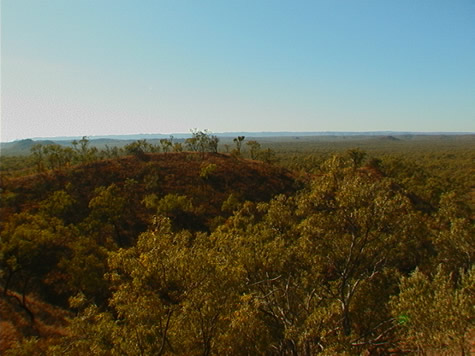2001 August 9, Thursday. Gulf Developmental Road.
Upon emerging from the back roads, we noticed considerable change not only of the road surface, but also of the surrounding farmland. Evenly grazed native grassland gave way to a different type of country, littered with vicious thorns, corkscrew seeds, and sticky burrs. And while the former might not have been quite what one would call lush pasturage, it was enough to see a difference that was saddening. (Not to mention unmerciful on our bike tubes.)

There is more than chance occurrence to account for the coincidence of the unkempt land and the major road. The rapid and frequent passing of traffic along the broad sealed road spreads seed (and plant disease) speedily. Cow head thorns will pervade a car tyre, and travel in just a few hours into areas where cattle walking and passing seed from beast to beast would take weeks or months to infiltrate. These types of grasses have adapted to dispersal by sticking to animal fur and piercing surface flesh, and are pitiless in the pursuit of any bare ground on which to take hold.
Community Landcare seems an impossible task in this environment. Weed management programs are out of the question, as none of the land is being used for horticulture, and none is being farmed intensively. Landcare as it exists out here appears to be restricted to the poisoning of pest animals – including natives - with 10-80, and the encouragement of pleasure shooters to hunt feral animals. These include the ever-present wild pigs, as well as rabbits, foxes, horses, and dingoes. Wild horses can travel enormous distances, spreading disease in domestic stock. One gentleman we spoke to out here told of how he was asked by landowners to shoot any brumbies he encountered, because they carried a disease similar to conjunctivitis.
While on the surface the landscape appears largely unproductive, the sheer volume of road kill that has confronted us during our time on the Developmental Road attests to the fact of there being an immense wild ecosystem in Cape York. The most concerted efforts of the relatively tiny station owners, and the people of settlements such as Georgetown, are dwarfed in the magnitude of untamed land out here. It becomes apparent that far north Queensland will remain an unbridled frontier for many decades to come.
bel